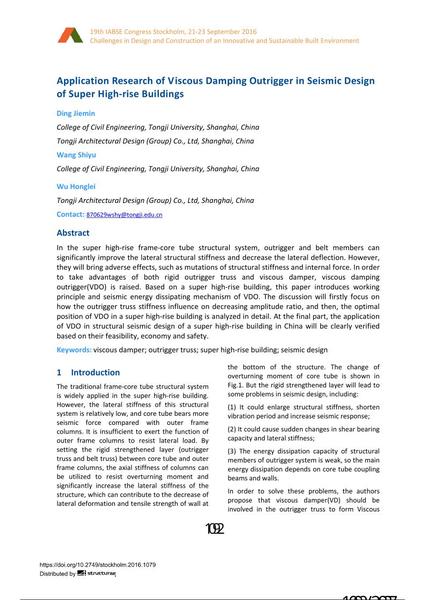Application Research of Viscous Damping Outrigger in Seismic Design of Super High-rise Buildings

|
|
|||||||||||
Bibliografische Angaben
| Autor(en): |
Jiemin Ding
(College of Civil Engineering, Tongji University, Shanghai, China Tongji Architectural Design (Group) Co., Ltd, Shanghai, China
)
Shiyu Wang (College of Civil Engineering, Tongji University, Shanghai, China) Honglei Wu (Tongji Architectural Design (Group) Co., Ltd, Shanghai, China) |
||||
|---|---|---|---|---|---|
| Medium: | Tagungsbeitrag | ||||
| Sprache(n): | Englisch | ||||
| Tagung: | IABSE Congress: Challenges in Design and Construction of an Innovative and Sustainable Built Environment, Stockholm, Sweden, 21-23 September 2016 | ||||
| Veröffentlicht in: | IABSE Congress Stockholm, 2016 | ||||
|
|||||
| Seite(n): | 1092-1099 | ||||
| Anzahl der Seiten (im PDF): | 8 | ||||
| Jahr: | 2016 | ||||
| DOI: | 10.2749/stockholm.2016.1079 | ||||
| Abstrakt: |
In the super high-rise frame-core tube structural system, outrigger and belt members can significantly improve the lateral structural stiffness and decrease the lateral deflection. However, they will bring adverse effects, such as mutations of structural stiffness and internal force. In order to take advantages of both rigid outrigger truss and viscous damper, viscous damping outrigger(VDO) is raised. Based on a super high-rise building, this paper introduces working principle and seismic energy dissipating mechanism of VDO. The discussion will firstly focus on how the outrigger truss stiffness influence on decreasing amplitude ratio, and then, the optimal position of VDO in a super high-rise building is analyzed in detail. At the final part, the application of VDO in structural seismic design of a super high-rise building in China will be clearly verified based on their feasibility, economy and safety. |
||||
| Stichwörter: |
Erdbebenbemessung
|
||||
